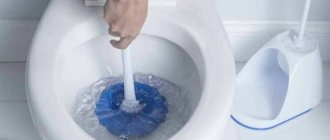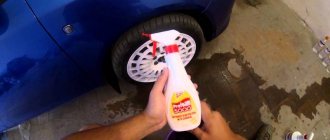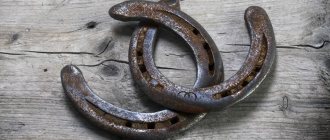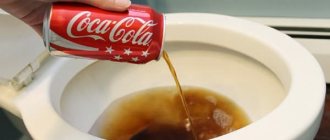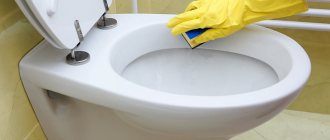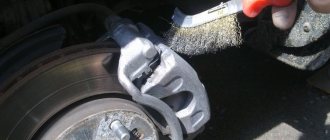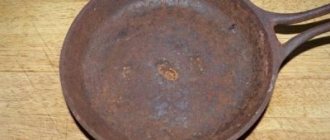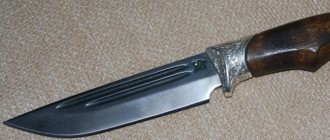The life of the driver and passengers depends on how well the braking system of a vehicle works. Therefore, it is so important to monitor the condition of all its elements, including brake discs.
If corrosion appears on them, it must be removed immediately. Read the article about why rust forms on brake discs and pads, what the danger is and how to deal with it.
Causes of rust stains
During active use of the car, rust does not appear on the discs, since they are constantly polished while driving.
However, even a short downtime of a few days leads to the formation of corrosion on the metal. This process is especially intense in conditions of high air humidity.
So, the main reason for the formation of rust on brake discs is prolonged idle time of the vehicle. These elements are not protected by anything, therefore, like any other metal parts, they oxidize.
When to clean a brake disc
The threat of corrosion spreading from the discs to other parts of the car prompts its removal whenever possible. If you have to remove a wheel, it’s worth spending a little time and cleaning the brake element - removing accumulated deposits with a wire brush and treating with a rust remover.
There are cases in which it is simply necessary to clean a rusted disk:
- Long-term parking of the car on the street. Due to the constant action of moisture, the part can literally become “overgrown” with brown growths. You will need to remove them from all surfaces. Brakes on such a disc will not work reliably; the pads will need time to wear off the corrosion layer.
- The growth of a deep layer of rust on non-working parts of the part. You can periodically clean it with improvised means. But it is better to carry out complete removal followed by application of protective compounds.
- Reduction in the cross-section of channels in ventilated discs due to corrosion of internal cavities. This leads to poor cooling of the part. Removing rusty build-up will restore air flow.
Why is corrosion dangerous and how often should it be cleaned off?
Some drivers believe that corrosion is a normal phenomenon and does not pose any threat . The main thing is to start driving and she will remove herself. In fact, this assumption is only partially correct.
Indeed, a thin layer of corrosion quickly disappears, but a thick coating that completely covers the discs cannot be dealt with in this way.
Rust is dangerous. It acts like a lubricant, increasing friction between the discs and pads. This results in reduced braking efficiency. On the road, especially when driving at high speed, this is a serious risk.
Another reason to get rid of corrosion is accelerated wear of the brake system . Corrosion acts as an abrasive, which leads to abrasion of the discs in those areas where it is most abundant.
In the future, the car will brake jerkily. If this happens, even cleaning will not be able to solve the problem. The part will have to be changed. Therefore, it is so important to get rid of corrosion in time, when the layer on the disks is still very small.
The corrosion removal procedure must be carried out in the following cases:
- The car was idle for a long time.
- The layer of rust is thick and covers non-working surfaces.
- Rust clogs the ventilation ducts. Their blockage threatens to overheat the braking system and cause rapid wear.
It is a good idea to clean the rims when changing wheels.
Why is rust harmful to a car?
The friction lining fully performs its functions only when it has a tight fit to the metal surface. Rust, especially small particles, gets between the disc and pad, increasing premature wear of both parts. When not driving for a long time, large crumbs can become jammed and remain on the rubbing surface. This leads to vibration when braking.
When the car is parked outdoors, the consequences can be even worse. A corrosion layer also appears on the working surfaces of parts. Deep depressions with a large area are formed on the disk. In this case, the wear of the pads is significant, even after several days of driving. In addition, vibration increases and damage to the entire chassis.
How to remove it?
You can deal with rust on brake discs using improvised means and the use of specialized compounds. Regardless of the chosen method of combating corrosion, the key to a successful procedure is strict adherence to the instructions.
Folk remedies for cleaning
Folk remedies work no worse than professional cleaners, but are much cheaper. You can deal with rust on wheels using the following compounds:
Lemon acid .
It is diluted in warm water. For every 10 liters you will need 50 g of preservative. The disk is completely immersed in the solution and left for 24 hours. After treatment, the product is washed with a soda solution and then with clean water (read more about removing rust using citric acid here).- Table vinegar . It is used like citric acid. For 10 liters of water you will need 250 ml of vinegar with a concentration of 9%. If the rust layer is thick, then the amount of vinegar is doubled (you can find out more here).
- Orthophosphoric acid . It can be purchased at construction stores. The discs are treated with this composition, left for 15 minutes, after which they are washed off with a soda solution and clean water.
- Soda slurry . It is convenient to treat small areas of corrosion. The product is prepared in such a way that its consistency resembles sour cream. The paste is applied to the rust, left for an hour, and then removed with a damp cloth.
- Sparkling water . To combat metal oxides, you can use Coca-Cola, Sprite or Pepsi. To increase the effectiveness of the procedure, the drink is slightly heated (up to 40 degrees). The disk is completely immersed in Cola and left for a day, after which it is removed, rinsed with clean water and dried.
All of the above products are harmless to metal, so they can be used as often as necessary.
Top 3 special lineups
You can get rid of rust using converters or removers, which are sold in auto parts stores. They have different release forms, so when purchasing you need to pay attention to the following points:
- Spray. It is chosen when you need to treat a small area of corrosion. The spray is convenient to apply, since there is no contact between the skin and the active substance.
- Liquid form . Such compositions are an ideal solution for removing rust from the entire disk. The solvent is poured into a suitable container and the part is completely immersed in it.
- converter . Such compositions not only help dissolve corrosion, they provide additional protection for the metal from its reoccurrence. This is why it is so important to purchase formulations with added zinc.
Regardless of the product you choose, before using it for the first time, you should carefully read the instructions.
Top 3 popular compositions for removing rust from brake discs:
Rust converter AUTOPROFIT Galvanization .
The composition is available in the form of a solution, which is bottled in convenient bottles equipped with a sprayer. The product removes rust and prevents its reappearance, creating a durable zinc coating on the surface. For 550 ml of the product you will need to pay 225 rubles.- Rust remover SYNTIROL . The product is available in liquid form. It has an immediate effect on corrosion, removing it in 4-8 minutes. The cost of 1 liter is 450 rubles.
- Spray for removing rust Rust Remover . The composition is completely ready for use. It is applied directly to the corroded area. After just 10 minutes you can evaluate the result. One package is enough to process 5 m2. Prices are here.
How to remove using the electrochemical method?
This is a complex but effective way to combat rust. To implement it, the following components will be required:
- current source, for example, a car battery;
- soda ash solution (1 tsp per 1 liter of water);
- plastic basin;
- stainless steel;
- wires and clamps.
Procedure:
Connect the drive to the power source using the “+” wire.- Immerse the part in the soda solution.
- Place a piece of stainless steel connected to the “-” terminal into the basin. The steel and the disc must not come into contact with each other.
- Turn on the battery and make sure the reaction is started. This will be indicated by the solution bubbling.
- Wait 2 hours.
- Disconnect the power source, remove the disc, rinse and dry it.
Although this method is labor intensive, it is very effective.
Chemical methods
All products are based on acids that react with iron. Currently available in three types: sprays, liquids and gels. Sprays do little to remove heavy rust. However, they do an excellent job with parts that are just beginning to show rust. Simply spray the mixture onto the rusty surface and wipe with a rag. The leaders among sprays are Liqui Moly and Forch P321.
Liquids are used together with mechanical cleaning methods. The product must be applied to the parts and left for some time. The liquid will react with the rust, making it much easier to clean. Corrosion removal gels are also called rust converters. They do not get rid of unwanted formations, but transform them into other compounds. After conversion, the part is wiped with a rag. Products such as Tsinkar and Felix work best.
Helpful information
Brake discs are made of cast iron, so when purchasing specialized compounds, you need to clarify whether the chosen product is suitable for this type of metal.
When working with chemicals, you need to take care of personal protective equipment . It is unacceptable to remove the part from the solution with bare hands. They must wear rubber gloves.
The cleaning procedure should be carried out in a room with good ventilation.
There is a lot of useful and important information about methods of fighting rust on a car in this section.
Corrosion protection KENT
With KENT Corrosion Protection sprayed onto the visible surface of the disc, the coating prevents corrosion from developing.
Features and Benefits:
- Prevents the formation of corrosion and rust.
- Creates an attractive appearance of the car based on a transparent coating system.
- There is no need to disassemble the wheels and clean the rims before starting the car.
- Without silicon.
- Safe for use in the truck.
- Does not affect vehicle safety.
Protective equipment depends on the characteristics of the vehicle. Wrong choices can lead to life-threatening accidents. Therefore, it is imperative to buy them from trusted manufacturers who produce products that meet safety standards.
Before cleaning a brake caliper from rust, you need to do the following:
- Clean the discs and let them dry.
- Shake the product well before use.
- Spray the product evenly until the disc has a sealed coating. Wait until it dries completely.
The use of folk remedies for corrosion
You can clean rust using household chemicals and substances. They are sold in hardware and grocery stores. It takes time to remove rust with their help. To use some of them, you will need a large container into which the corroded part is completely placed.
Lemon acid
You need to treat contaminants with it like this:
- Take citric acid powder at the rate of 10 grams per liter of water.
- Dissolve the powder in warm water.
- Fill the rusty disk completely with the resulting solution.
- Wait a day for the dirt to be removed.
- After removing the disc, wipe it and then rinse it with a soda solution to prevent oxidation.
Certain areas of the surface can be wiped with juice squeezed from lemon.
Vinegar
Food vinegar can remove rust. It must be poured into a container so that the disc to be cleaned is completely immersed in liquid. Let the part stand for at least 12 hours. Then rinse with soda solution and dry.
A mixture of vinegar and citric acid
Mix both solutions in equal proportions. Apply the finished mixture to small rusty deposits. Wait 1 – 2 hours, then wipe dry.
Baking soda
Dilute it with water until it becomes mushy. Place the resulting slurry on the rusty area. Wait half an hour and wipe with a rag. For larger stains, repeat several times.
Orthophosphoric acid
It is part of many rust removers, but it can be found in its pure form in hardware stores. You need to apply it like this:
- Apply with a brush or foam roller to the rusty disc.
- After foam appears, wait no more than 30 seconds.
- Wash off the resulting white film with water, wiping with a brush or cloth.
- Wipe the part dry.
It is not recommended to use strong acids - hydrochloric or sulfuric. Under their influence, undamaged areas of metal can also be removed.
Why does rust appear?
Oddly enough, brake discs are made of metals that have low resistance to rust. And the process of its appearance begins as soon as moisture accumulates on the disk. Why not use stainless metals to make discs? It's simple. They have a very low coefficient of friction. The place where the brake disc comes into contact with the pads is called the working surface.
In this place, rust practically does not form due to frequent friction. But if the car sits for a long time, then corrosion can form at the points of contact, which has a bad effect on the car’s braking in the future. A non-working surface suffers from corrosion like no other. In addition, corrosion can crumble and fall onto other parts of the brake system.
Cleaning disc brake pads
03 Jan 2014, 09:32
03 Jan 2014, 10:23
14 Mar 2014, 20:20
14 Mar 2014, 20:30
14 Mar 2014, 20:50
14 Mar 2014, 21:02
elixir r + quaxar gaylight 160 mm = I squeak even less than Grisha. Never cleaned it.
I admit that you need to clean it when lubricants get on the braking surfaces.
14 Mar 2014, 21:07
14 Mar 2014, 21:39
14 Mar 2014, 21:52
02 Apr 2014, 20:28
